I made my second trip out to NCSE HQ a couple of weeks ago. In addition to basking in the 70° sunshine, the trip was fabulous because it yielded some new ideas and exciting discussions. No details yet, but watch this space—things are going to get awesomer (yep, that’s a word—or it is now).
One of the ideas we came up with was a new blog series in which we will review a classroom resource and put on our teacher hats to discuss how it could be used. Qualifications for consideration are that the resource must: 1) be free; 2) have something to do with evolution, climate change, or the nature of science; and 3) be terrific. When we can, we will connect with actual in-the-classroom teachers to get their thoughts. If you are a teacher and interested in providing feedback please let us know! We’d love suggestions for resources and a list of opinionated teachers to contact. And now, on to the post.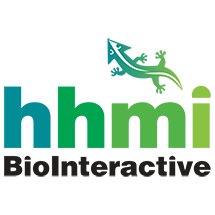
First up for me is the HHMI short film The Making of the Fittest: Natural Selection and Adaptation. I have alluded to HHMI’s BioInteractive and its resources several times in this blog (in fact, another one of its short films launched me into a multi-week exploration of fossil misconceptions) but I’m delighted to have the chance to talk more about both the program and this resource in general.
Anyone who has attended a teacher conference in the last five or so years has probably encountered BioInteractive. Their booth, presentations, and associated staff and teachers have been part of the NSTA and NABT conference landscape for a while now. The mission of BioInteractive is to supply educators with free resources to teach science. Because HHMI has the world’s best scientists in its Rolodex, the quality of its multimedia materials is far above the norm. But what makes them even more attractive is that educators work closely with the scientists in the conception, development, and piloting of the resources.
 Sean Carroll became HHMI’s vice president of education in 2010, a position that puts him in the lead at BioInteractive. Carroll brought with him a desire to tell stories—to make learning science more like engaging with a good book than memorizing facts. One of his primary contributions along this line was to oversee production of a series of short films designed for classroom use; The Making of the Fittest: Natural Selection and Adaptation is one of these films.
Sean Carroll became HHMI’s vice president of education in 2010, a position that puts him in the lead at BioInteractive. Carroll brought with him a desire to tell stories—to make learning science more like engaging with a good book than memorizing facts. One of his primary contributions along this line was to oversee production of a series of short films designed for classroom use; The Making of the Fittest: Natural Selection and Adaptation is one of these films.
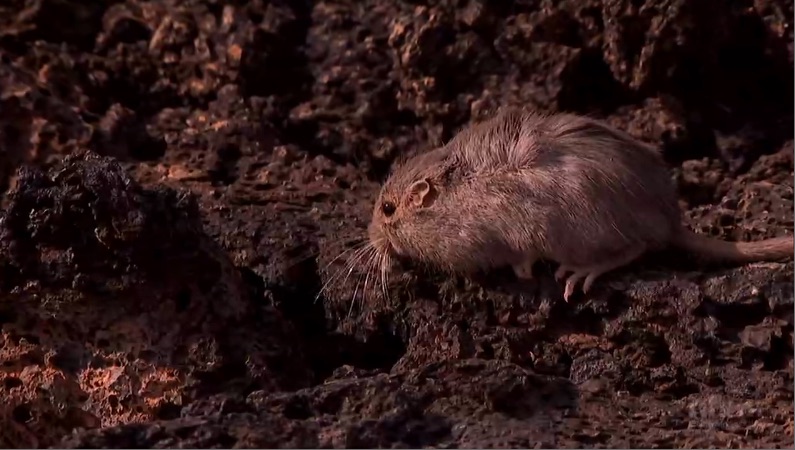 The first thing to know about it is that it’s short—just over ten minutes long. So the video will not take up an entire class period, but it contains more than enough material to serve as the foundation for several lessons. The film tells the story—there’s that word again—of the rock pocket mice in the American Southwest: There are dark
The first thing to know about it is that it’s short—just over ten minutes long. So the video will not take up an entire class period, but it contains more than enough material to serve as the foundation for several lessons. The film tells the story—there’s that word again—of the rock pocket mice in the American Southwest: There are dark  mice and light mice, dark rocks and light rocks, and lots of predators that rely on sight to catch a meal. Sound familiar? It’s a compelling and straightforward example of evolution by natural selection, and the film highlights two stellar scientists and communicators—Sean Carroll and Michael Nachman.
mice and light mice, dark rocks and light rocks, and lots of predators that rely on sight to catch a meal. Sound familiar? It’s a compelling and straightforward example of evolution by natural selection, and the film highlights two stellar scientists and communicators—Sean Carroll and Michael Nachman.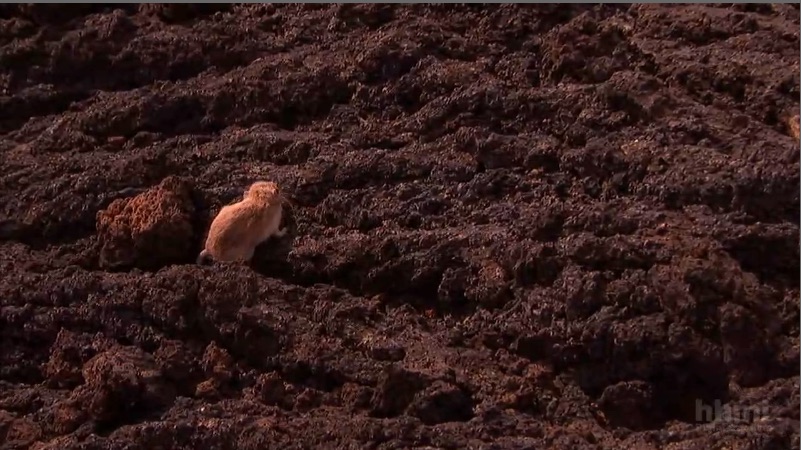
What really makes this resource stand out, however, is the number of misconceptions it touches upon. This one ten-minute film gives you opportunity after opportunity to probe your students’ understanding. For example, at one 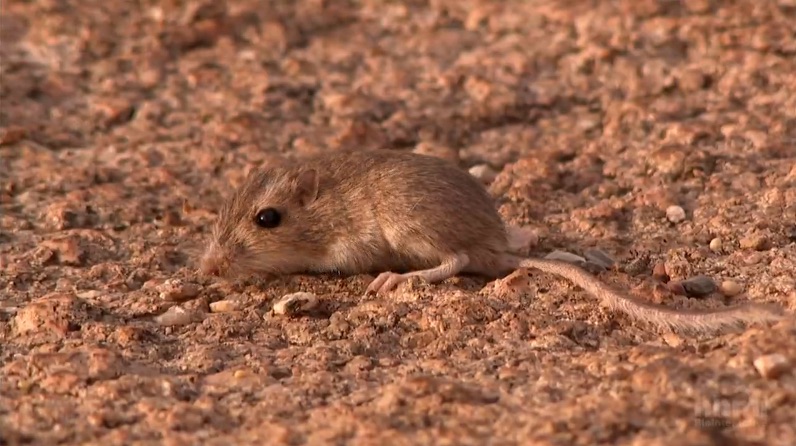 point, we learn that the dark-colored mice have white underbellies because “presumably there’s no selection for dark on the belly because predators are coming from above.” So you can ask “why are the mice’s bellies white?” In this case, it’s not necessarily because there is an advantage to a white belly, but rather, it could be because there is no disadvantage! Not all traits are adaptive!
point, we learn that the dark-colored mice have white underbellies because “presumably there’s no selection for dark on the belly because predators are coming from above.” So you can ask “why are the mice’s bellies white?” In this case, it’s not necessarily because there is an advantage to a white belly, but rather, it could be because there is no disadvantage! Not all traits are adaptive!
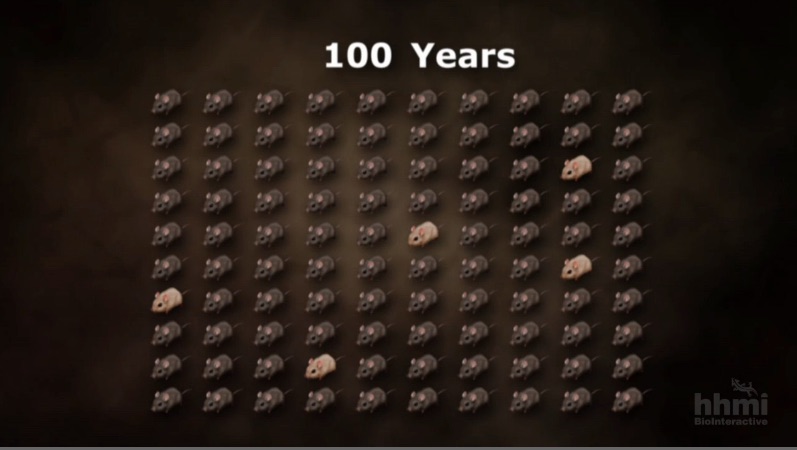 Later, Carroll models the effect of a survival advantage of 1%, such as minor change in fur color might confer. It turns out that such a seemingly slight leg up is enough to result in a nearly complete shift to dark coloration in just 1000 years. A 10% competitive advantage can do the job in just 100 years. Why is this significant? Because a 1%–10% advantage is a very strong selection pressure and because the population living on the dark basaltic rocks is made up of nearly, but not completely, dark-colored individuals. Natural selection does not weed out all disadvantageous variations!
Later, Carroll models the effect of a survival advantage of 1%, such as minor change in fur color might confer. It turns out that such a seemingly slight leg up is enough to result in a nearly complete shift to dark coloration in just 1000 years. A 10% competitive advantage can do the job in just 100 years. Why is this significant? Because a 1%–10% advantage is a very strong selection pressure and because the population living on the dark basaltic rocks is made up of nearly, but not completely, dark-colored individuals. Natural selection does not weed out all disadvantageous variations!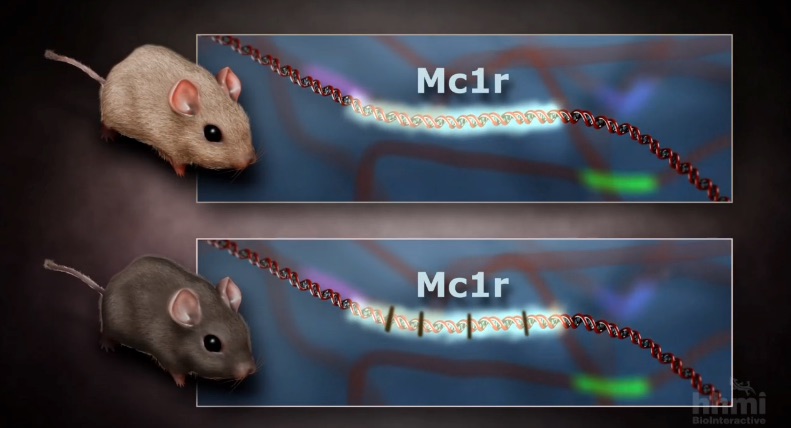
And finally, Carroll compares two different, dark-coated populations of mice and explains that a different, random and rare mutation arose in this second population that produced the same result as in the first population: a mouse with dark fur. Not because the mice needed to be dark, but because…luck! And because the selection pressures exerted on both populations were similar, the overall evolutionary effect was also the same—a population of mice made up almost completely of dark-colored individuals. Evolution is neither entirely random nor predictable!
It’s like shooting misconceptions in a barrel.
Among the materials to supplement the film are several activities, a quiz, and two guides (scroll to the bottom of the page). Many of these ancillaries, such as those that explore the Hardy-Weinberg principle and molecular genetics, are somewhat advanced (more for AP and honors biology than for standard college prep), but there is likely to be something that will work for your group. (Full disclosure: I worked on many of them.) That said, the film on its own is enough.
So what are you waiting for? Go! Stream the film or request a DVD and see if Carroll is right—does telling a story make science more engaging? I think that we all know the answer.
Are you a teacher and want to connect with us? Do you have an idea for a future Misconception Monday or other post? See some good or bad examples of science communication lately? Drop me an email or shoot me a tweet <at>keeps3.

